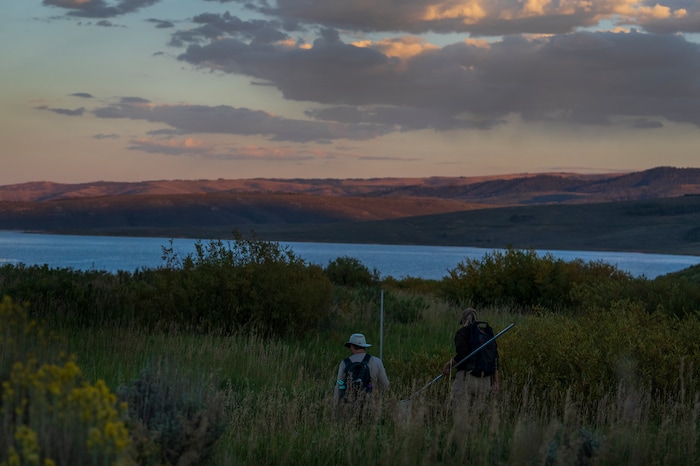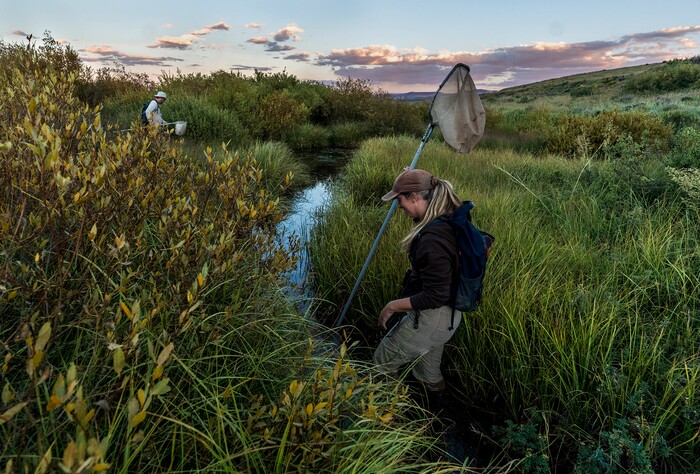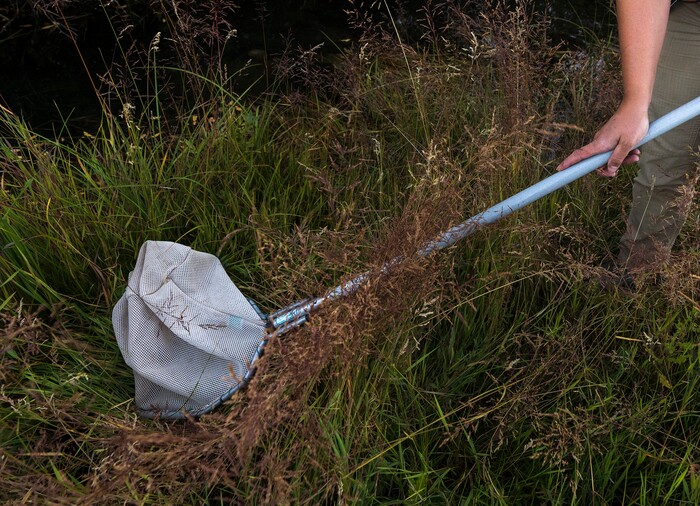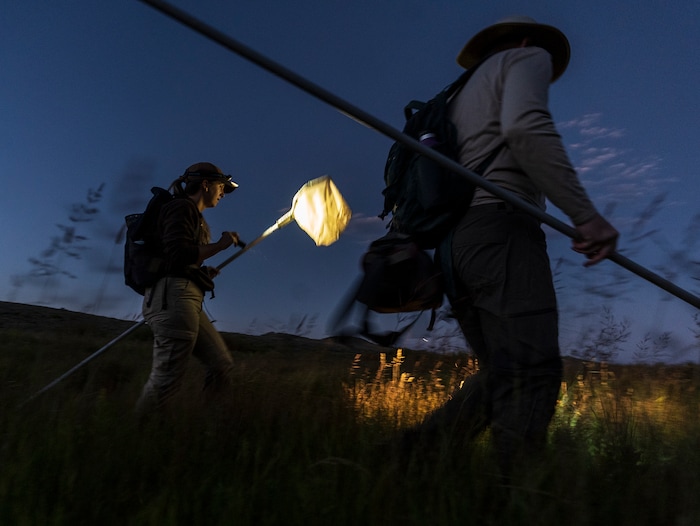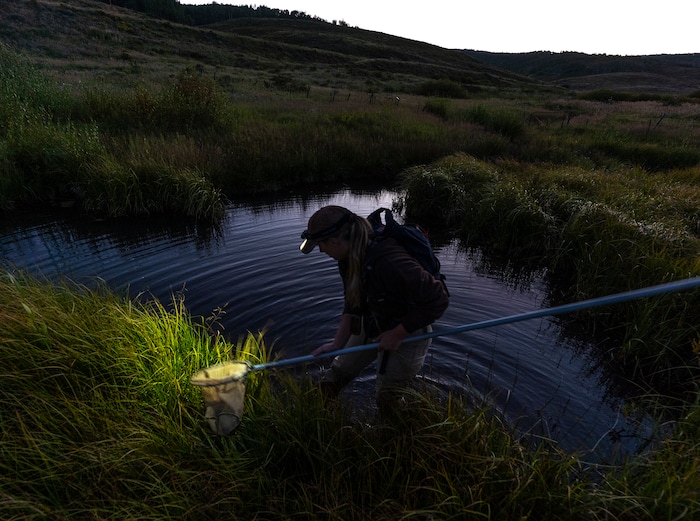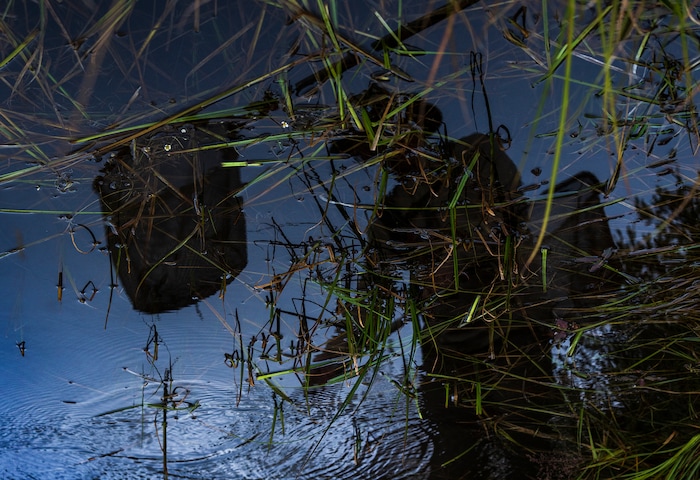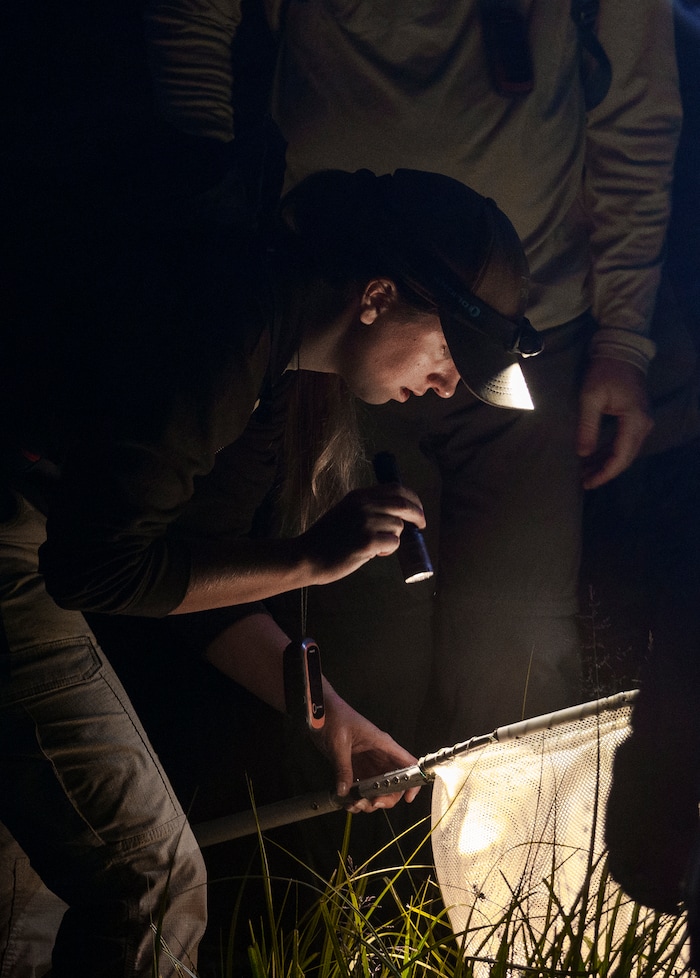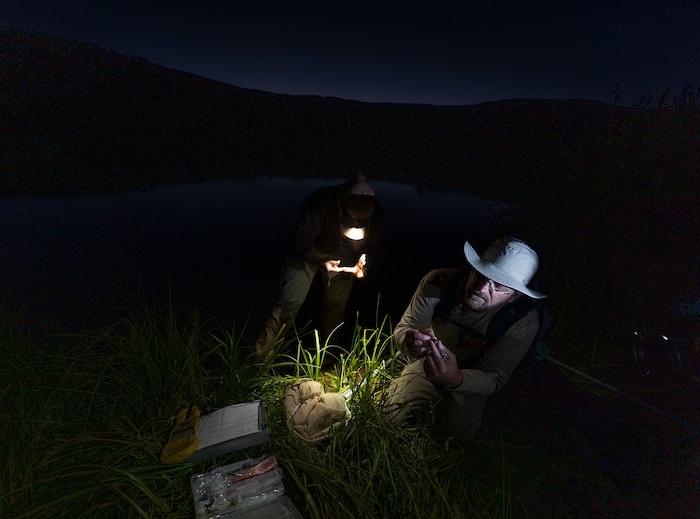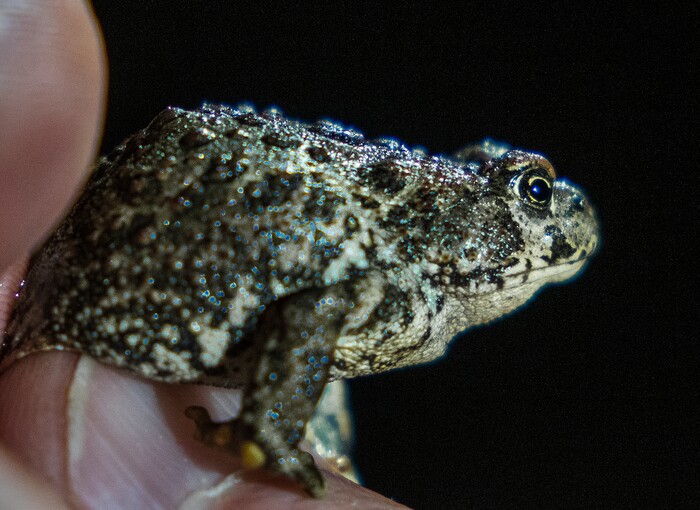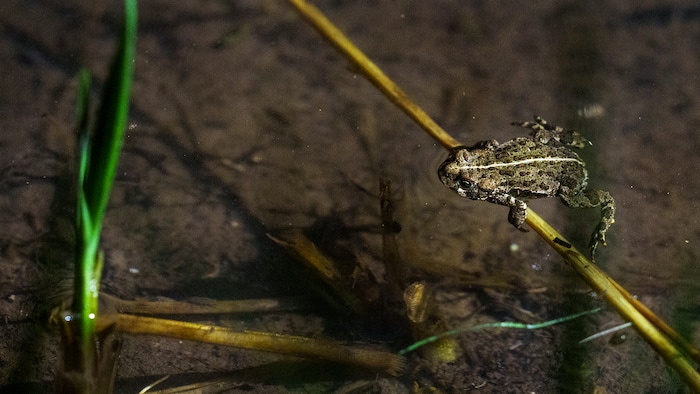Strawberry Reservoir • Just before nightfall, Keith Lawrence and Kaitlyn Purington each threw a long net over their shoulder on the last day of August and set off into the untamed brush and marsh just beyond the banks of Strawberry Reservoir.
Since workers diverted and dammed creeks and streams in the Strawberry Valley to create this reservoir in the early 1900s, it’s been a popular recreation destination. State employees have stocked this body of water with more fish than any other over the last decade, according to state data, giving anglers a chance to reel in coveted cutthroat and rainbow trout and kokanee salmon.
But just beyond the reservoir’s banks, where the water drains into narrow, serpentine streams lined by tall grasses and short, stocky willows, these Division of Wildlife Resources employees have another animal on their mind: boreal toads.
In past surveys, Lawrence said, staff normally recorded about a dozen toads. Once, surveyors found 20.
But recently, that’s changed. It’s not a cause for alarm — not yet, at least — Purington said. Any number of reasons could explain the absence, like the new pond that formed along the stream, thanks to an industrious group of local beavers. Maybe surveyors were missing toads because they were looking during the day, and these amphibians were perhaps more active at night. Maybe the toads were there but no one saw them.
(Leah Hogsten | The Salt Lake Tribune) Boreal toad search in Bryant's Fork of Strawberry Reservoir March 1, 2022. conservation efforts to help the boreal toad, whose populations levels were declining rapidly years ago but who have recently seen some success because of efforts to raise "assurance colonies" at Hogle Zoo and elsewhere and release them into the wild. Habitat restoration has also been helpful. .
Regardless, Lawrence said it’s puzzling. So that Wednesday evening, he and Purington decided to check out the nocturnal theory.
They hoped to find some toads, yes, but also to record data that adds to a growing body of research in Utah and the Mountain West that is responsible for bolstering boreal toad numbers after dramatic losses over the last 20 years.
The story of the boreal toad, so far, is a conservation success. The U.S. Fish and Wildlife Service considered listing the toads for protection under the Endangered Species Act, but ultimately decided against it 2017 — partly because of Utah’s efforts to study and reintroduce them back into the wild, oftentimes after restoring their wetland habitats, experts said.
Yet water woes in the West and the ongoing threat of a fatal fungus means the fate of boreal toads remains uncertain, and wildlife researchers need civilian help to ensure populations remain stable.
Small toad, big impact
Boreal toads don’t draw the same attention as other native Utah species, like mountain lions or bighorn sheep, but they play an important role in Utah’s high-altitude ecosystems, said Sarah Seegert, the wildlife division’s native aquatics assistant section chief.
Because the toads respirate through their skin in water, they’re sensitive to changes in their wetland biomes. If these toads are doing well, that means the habitat is doing well, too, and can serve its role as a sort of environmental sponge, Seegert said, soaking up water so it doesn’t flow too quickly downstream and can then pool to support other animals.
Kayleigh Mullen, a biologist at Utah’s Hogle Zoo, said that amphibians, in general, are essential in food chains, since they live full and varied life stages both in land and on water, where they eat and are prey for other animals in the ecosystem.
“Once they start declining,” Mullen said, “you can make some pretty safe assumptions that environment is declining.”
Which is what experts saw happening to the state’s riparian corridor over the last two decades, Seegert said, as more waterways were channelized or otherwise degraded by livestock and recreational vehicles, or lack of beavers and other native species.
Since then, the state and other groups have worked to repair some of these wetland areas by reintroducing beaver populations, building artificial dams, and reintroducing native plant species that will help to ensure toads can use the marsh, researchers said.
Boreal toads, in particular, spend a lot of time on land and require a large landscape to survive, spending the spring in breeding ponds, summers in foraging grounds and winters at separate hibernation sites, Mullen said.
As Utah’s human population increases, Seegert said there’s a concern that development could lead to increased habitat destruction and put these toads — and any other native species — at risk. The state’s shift to a warmer, drier climate also is problematic.
Without enough snowpack, mountain streams dry up and reduce the places where these toads can breed. Without access to a spot to soak at least once a day, a toad loses its ability to breathe and can die.
Yet it’s hard to convince people to care about these toads for the same reason it’s hard to find them in the wild — they’re inconspicuous, just a few inches across at their biggest and, save for the chirpy release call they let out when stressed, they’re mostly quiet.
What are boreal toads?
(Trent Nelson | The Salt Lake Tribune) A boreal toad at Hogle Zoo in Salt Lake City on Thursday, Aug. 18, 2022.
Boreal toads typically live in wetlands between 6,500 and 11,000 feet, said Kayleigh Mullen, a biologist at Utah’s Hogle Zoo.
They’re green, grey and brown, like the algae-laden, muddy streams they live in. Their backs are covered in soft bumps and bisected with a distinct, yellowish line. Once metamorphosed from a tadpole, they range in size from about an inch to about 4 inches, with beefy, stumpy legs. When stressed, they release an odor that some say smells like peanut butter.
“It’s like, ‘Stay away from me. I’m going to smell super tasty,’” Mullen joked.
Mullen tends to the zoo’s colony of boreal toads, which they’ve recently begun breeding to release into the wild to help bolster populations in southern Utah, near Bryce Canyon.
Until recently, Mullen and her team had been unable to breed the toads by simply putting males and females together. A breakthrough at the Denver Zoo in 2019 unlocked the secret to in-captivity breeding: simulating the amphibians’ winter hibernation.
Mullen said staff raised their first batch of tadpoles in 2020 and later released 64 of them into the Paunsaugunt Plateau within Bryce Canyon’s borders in August 2021. When crews returned this year, they found at least seven had survived.
This upcoming breeding season, Mullen is hoping to raise considerably more.
“I swear, I remember being a kid and getting tadpoles from a pond, and they would grow and I would release them. And it seemed like a very simple process,” she said.
But dialing in the proper tadpole habitat in captivity is hard work. Biologists must grow the right food — as in algae — and run water filters at the proper setting to provide adequate water quality.
The hope is that lessons learned through developing the Paunsaugunt Plateau assurance colony can help toad populations bounce back in other parts of the state and the West, said Kevin Wheeler, a native aquatics biologist with the wildlife division.
Searching for toads in the wild
Lawrence and Purington had been searching for toads for about two hours Aug. 31 with no luck. The sun had long set, beavers had already exited their lodge for a night of foraging and a hangnail moon hung in the pitch black sky.
The moon’s soft glow, the bright stars and headlamp beams provided the only light. Coyotes howled faintly, miles away.
The pair had already looked in most of the places they’d previously found toads. Hope was dwindling. They sloshed across the banks of a larger pond, near a beaver dam. Others busied themselves looking at dead crayfish that had washed along the shore.
Then the came the whoosh of a net flying through the air and plopping into the water. “We got a toooooooad!,” Purington called. She said she spotted it crawling along the dam, making its way into the water.
“She’s got a good eye,” Lawrence later said.
This toad was a juvenile — over an inch long and weighing just 3 grams — and surprisingly cooperative, staying put in Lawrence’s hand as Purington collected measurements.
They soon dropped this toad back into the water, where it kicked away along the shoreline. Lawrence said it’s good to find juveniles because that means the population here is breeding.
“I had hoped we’d see more,” Lawrence said, “but I’m definitely relieved that we found this one.”
Two minutes later, another juvenile toad was spotted near where the first toadlet, tentatively named “Path of Toadality,” was let go.
The second was measured, dubbed “Arugula,” and released. Moments later, it sunk back into the water.
There are some people, Lawrence said, who may never understand the importance of conserving these toads and other smaller native species. But they should understand that the animal’s fates, in many ways, are intertwined with our own.
“I think it’s important for people to understand that when they’re suffering, they’re often not the only species that are,” Lawrence said.
How to help protect boreal toads:
Through the Hogle Zoo’s community scientist program, volunteers can survey for boreal toads with zoo and Division of Wildlife Resources staff. Sageland Collaborative also hosts volunteer programs to collect water samples and information about eggs, tadpoles and toads.
You can also log any boreal toad encounters on iNaturalist, a social network of citizens and scientists. To make sure your entry is useful, be sure to get a clear picture of the toad and record the precise location where it was found.
If you see boreal toads in the wild, don’t touch them. Remember to pack out trash and watch where you step. Avoid driving through and camping close to their habitats in high-altitude marshes.
To prevent spreading the deadly “chytrid” fungus that has wreaked havoc on boreal toad populations, be sure to decontaminate equipment, clothing and vehicles that touched toad habitats with a 10% solution of bleach, officials advise.

